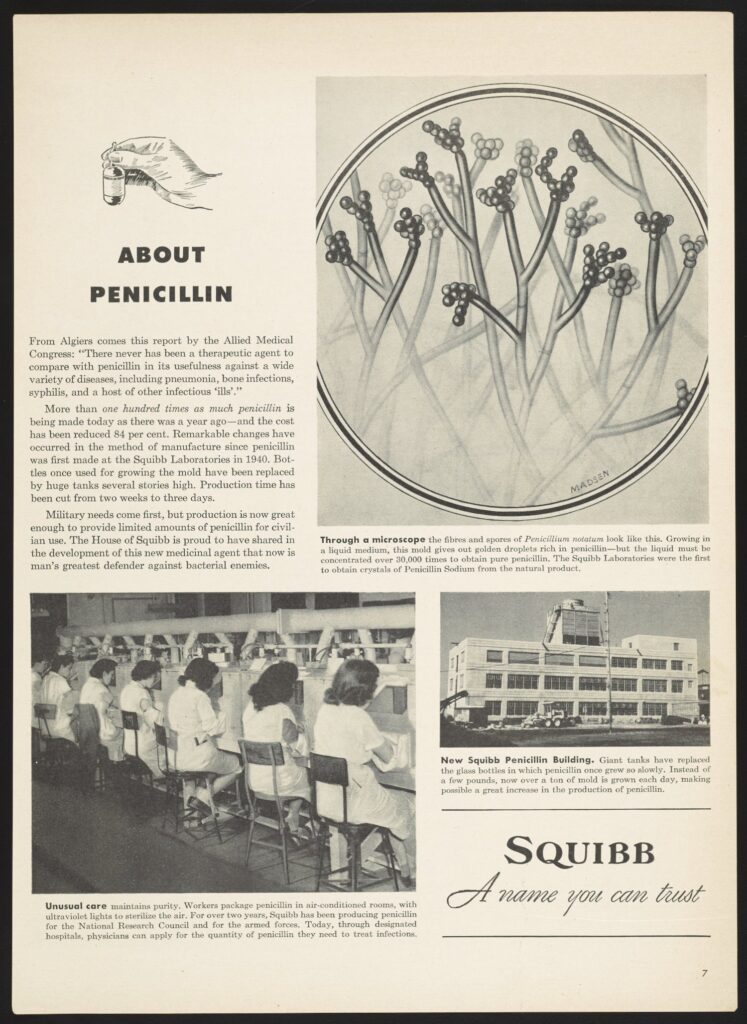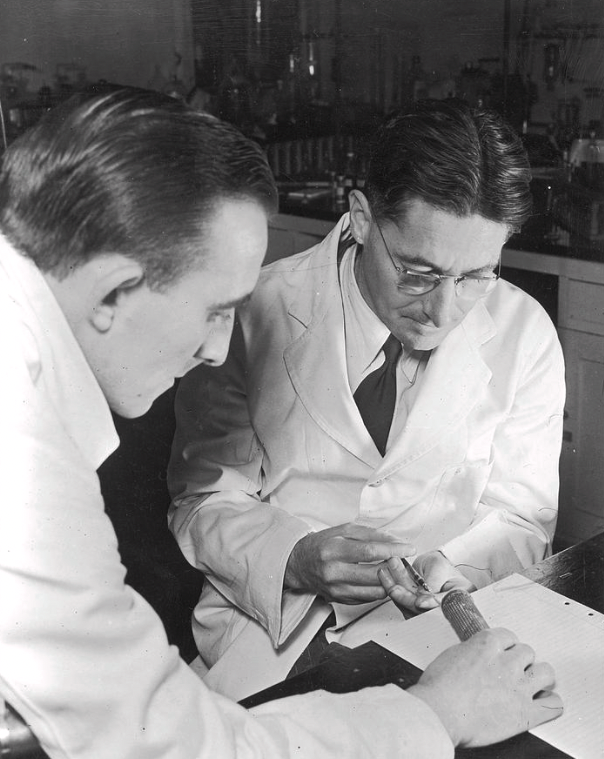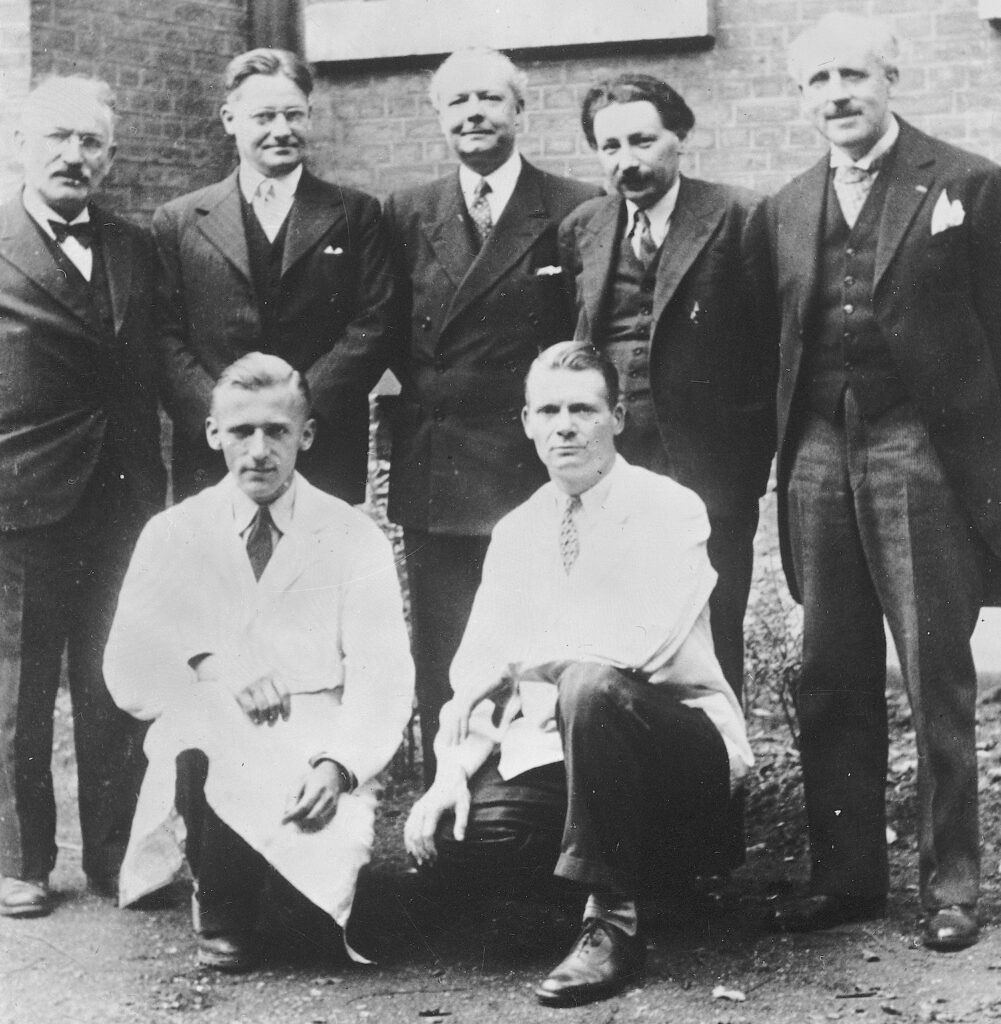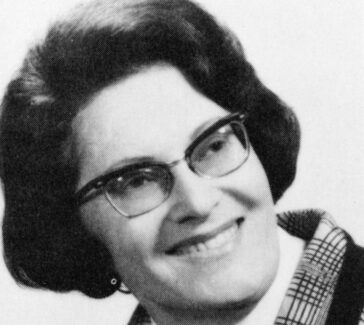Howard Walter Florey and Ernst Boris Chain
After Alexander Fleming’s 1928 discovery of penicillin, Florey and Chain’s further research enabled the testing and production of the drug.

Howard Walter Florey (1898–1968) and Ernst Boris Chain (1906–1979) were the scientists who followed up most successfully on Alexander Fleming’s discovery of penicillin, sharing with him the 1945 Nobel Prize in Physiology or Medicine. Florey and Chain each brought scientific knowledge and talent to the effort that filled out the other’s contribution, but the two were mismatched in terms of their personalities.
Florey’s Early Life and Education
Florey was born in Adelaide, Australia, the youngest of five children and the only son of an English shoemaker who had immigrated to Australia hoping to save his first wife and two eldest daughters, who were suffering from tuberculosis. He established a boot and shoe factory, which prospered during much of Florey’s youth.
From an early age Florey knew that he wanted to study medicine, perhaps because an older sister was already a medical student. She teased him about wanting to become “another Pasteur” (see Louis Pasteur), thus forecasting his interest in medical research. In 1922 he graduated with degrees in science and medicine from the University of Adelaide, which at that time specialized in preparing general practitioners, not researchers. On the basis of his fine academic record and his prowess as a tennis player, he was awarded a prestigious Rhodes Scholarship to study at Oxford University in England.
At Oxford his hunger for research was fed at the Honours Physiology School, which was headed by the great neurophysiologist Sir Charles Sherrington. After completing his scholarship Florey spent a summer as the physician on an Arctic expedition and the following year as a research student at Cambridge University. He then accepted a fellowship from the Rockefeller Foundation in New York that enabled him to work in the laboratory of American pharmacologist Alfred Newton Richards at the University of Pennsylvania. Soon after he returned to England, he began working toward a PhD in pathology at Cambridge. There he was inspired by the biochemist Sir Frederick Gowland Hopkins, head of the Sir William Dunn Institute of Biochemistry and famous for his work on vitamins. Florey also worked with Albert Szent-Györgyi, who was trying to isolate vitamin C.

The Penicillin Project
After holding the first few positions in his career as an academic, he returned to Oxford in 1936 as the director of the Sir William Dunn School of Pathology. There he recruited an interdisciplinary group of scientists, a choice that reflected the various approaches to disease to which his education had exposed him—studies not just of the pathological evidence of disease but also of the physiological processes by which those symptoms arose, traced to the chemical and even the molecular levels. By 1940 Florey had assembled a professional staff of about a dozen scientists plus technicians to work on the penicillin project alone. Among his first hires was the biochemist Ernst Chain, who came highly recommended by Frederick Hopkins at Cambridge and who was charged with developing a biochemical unit within the Dunn School.
Chain: Scientific Genius
Chain, a recent immigrant to England, was of Russian-German-Jewish descent. He was quite confident in his own ability and had a volatile temperament that was bound to clash with Florey’s similarly quick temper. When Chain was only 13, his father, an industrial chemist, died. The family’s economic status declined precipitously, causing his mother to convert their home into a guest house. The father’s influence lived on in the son, however, and Chain chose a scientific course of studies, graduating in chemistry and physiology from Friedrich Wilhelm University in Berlin in 1930.
After completing his degree he worked at premier German research institutes—briefly at the Kaiser Wilhelm Institute for Physical Chemistry and Electrochemistry and then in the chemical department of the Pathology Institute at Charité Hospital in Berlin, where he obtained his doctorate. Chain left his native Berlin for England in 1933, as soon as the Nazis came to power, leaving behind his mother and sister (who would both perish in the Holocaust). From childhood Chain’s musical gifts were comparable to his scientific genius, and at virtually every career decision point through his 20s—even after he came to England—he entertained the possibility of becoming a professional pianist instead of a scientist.
The first job offer in response to his many letters of application in his new country came from the chemical pathology department at University College Hospital Medical School, London. Chain took the position but quickly alienated himself from the rest of the department, partly through his endless complaints about the low quality of laboratory equipment in comparison with the situations he had known in Germany. Chain then worked at Cambridge under Florey’s mentor Hopkins from 1933 to 1935 before coming to work with Florey at Oxford.
Purifying Penicillin
One of the projects pursued at the Dunn School was the crystallization of lysozyme—an enzyme discovered by Alexander Fleming in 1921 with antibacterial properties—and the characterization of its substrate—the location on bacteria to which it usually attaches. In 1938, while the lysozyme research was concluding and during a rare period of great camaraderie, Florey and Chain decided to study the biochemical and biological properties of selected antibacterial substances produced by certain microorganisms—among them penicillin. They mistakenly thought these substances were all enzymes like lysozyme. While Florey and Chain were assembling grants to support their research, work was begun on penicillin.
Chain, along with another chemist, Edward Penley Abraham, worked out a successful technique for purifying and concentrating penicillin. The keys seemed to lie in controlling the pH of the “juice,” reducing the sample’s temperature, and evaporating the product over and over (essentially freeze-drying it). In this early process many gallons of mold broth were used to produce an amount just large enough to cover a fingernail. This excruciatingly inefficient process was later improved on by Norman Heatley—another biochemist on the research team assembled by Florey—and a succession of other scientists.
Testing Penicillin

In March 1940 Chain ran down to a laboratory that maintained test animals and requested that two mice be injected with a sample of the penicillin he and Abraham had extracted. Though the injection represented a far higher dosage than that administered in Fleming’s similar experiment, the mice survived apparently unharmed; the more concentrated penicillin had passed its first toxicity test. Florey then directed that the antibacterial properties of penicillin in mice be tested—the crucial step that Fleming had not taken.
On May 25 eight mice were injected with hemolytic streptococci (which among other diseases causes puerperal fever in new mothers), and four of these were subsequently injected with measured and timed doses of penicillin. Sixteen-and-a-half hours later the four mice that had received penicillin were alive, but their untreated fellows were dead—a finding that caused great excitement among the researchers. Further testing involving hundreds of mice was carried out through the summer.
On August 24, 1940, Florey and Chain reported their findings in the Lancet; the article electrified research groups around the world that were seeking cures for bacterial disease. By then World War II had already engulfed Europe, and the military importance of a more successful means of combating the diseases and infections that had decimated armies of the past was immediately recognized.
In early January 1941 Florey was ready to test penicillin on humans. The first English patient to whom the drug was administered was a young woman whose cancer was beyond treatment and who had agreed to test penicillin’s toxicity. She showed an alarming reaction—trembling and sharply rising fever. However, Abraham was able to show that impurities in the drug, not the drug itself, had caused the adverse reaction. In February a policeman became the first patient with an infection to be treated with penicillin in the hope of achieving a cure.
No one knew the dosages and the length of treatment required to eliminate various bacterial infections; these parameters were being worked out by just such trials—primitive by today’s standards. The policeman’s condition at first improved with the penicillin therapy and then relapsed. The penicillin supply had almost run out, and even retrieving penicillin from the man’s own urine (a commonly used procedure in the early clinical trials) failed to save him. Florey vowed that from then on he would always have enough penicillin to complete a treatment.
Production and Scaling Up
Increasing production and yields now became of overriding importance. Because Penicillium mold requires air to grow, it was first surface-cultured in regular laboratory flasks. Soon all manner of vessels were being used, including hospital bedpans and hundreds of made-to-order ceramic pots. The operation quickly outgrew the space assigned to the Dunn labs, and neighboring facilities at Oxford were borrowed for the duration. More personnel had to be hired, including six “penicillin girls” who handled the culture pots in the cold room of the extraction plant.
Florey had constructed a veritable penicillin factory within the precincts of the ancient university, an institution that had stood proudly aloof from industry for centuries. But when Chain urged that a patent be sought on penicillin, as was usual in German research institutes, Florey refused to enter into such a commercial agreement on a discovery he presumed would benefit all mankind—a decision that long rankled Chain.
To increase penicillin supplies, Florey approached various British pharmaceutical firms, but only ICI considered itself in a position to accept the challenge (though many later joined the effort). British pharmaceutical firms were already committed to manufacturing other drugs needed for military and civilian populations, or, worse, their facilities had been devastated by enemy bombardment. To obtain the assistance of the United States, then still a noncombatant, in increasing production and furthering research, Florey and Heatley flew across the Atlantic in the beginning of July 1941.
The American Connection
Florey’s American connections served him well. The two English emissaries spent the Fourth of July weekend with a friend from his Rhodes year, who put Florey and Heatley in contact with the U.S. Department of Agriculture’s Northern Regional Research Laboratories (NRRL) in Peoria, Illinois, where large-scale fermentation processes were being actively studied. A. N. Richards, Florey’s old laboratory director at the University of Pennsylvania, had become chair of the Committee on Medical Research in the Office of Scientific Research and Development, which was organized to marshal the strength of the Allies.
Because Richards knew Florey’s character, he decided to expedite unified action on penicillin on the basis of just one presentation. At the height of the program the British-American penicillin effort involved thousands of people and some 35 institutions: university chemistry and physics departments, government agencies, research foundations, and pharmaceutical companies.
In mid-September, Florey flew back to England to lead the clinical trials that eventually took him as far afield as North Africa and the Soviet Union (then one of the Allies). Heatley stayed at the NRRL and later moved to Merck and Company in Rahway, New Jersey, to help iron out problems in scaling up penicillin production.

Synthesizing Penicillin
Some chemists were confident that they would soon be able to synthesize penicillin from a few organic chemicals. This attitude resulted in a major effort conducted on both sides of the Atlantic to understand the structure of the penicillin molecule as the prerequisite for its eventual synthesis.
At Oxford the problem of determining penicillin’s structure was given to Chain, Abraham, and Robert Robinson, a senior organic chemist already famous for solving the structures and the synthesis of many complex molecules derived from natural substances. By fall 1943, groups working at Oxford and at Merck had proposed two different structures for the atomic groups central to the penicillin molecule.
One proposal—advanced by Chain and Abraham, as well as by Robert Burns Woodward at Harvard University—held that a four-membered beta-lactam ring lay at the heart of the penicillin molecule. Robinson instead proposed a structure based on oxazolone.
Meanwhile new instrumental techniques for analyzing the structure of organic molecules had become available, including X-ray crystallography, which was practiced by Dorothy Crowfoot Hodgkin, a near neighbor of the Oxford chemists.
In 1945 she was able to provide physical evidence confirming Chain and Abraham’s deduction and countering Robinson’s proposed structure. Unfortunately, Hodgkin’s work on the molecule culminated too late in World War II to be used in devising a synthesis for penicillin.
Even after 1957, when such a synthesis was created, fermentation continued to underlie the commercial production of penicillin and related antibiotics. But the structural knowledge gained in the war years proved invaluable in developing penicillin-like antibiotics after the war that could be administered more conveniently, were more effective, and had fewer side effects.
Florey’s Later Research
With World War II over and the Nobel Prizes distributed to Fleming, Florey, and Chain for their work on penicillin, Florey continued to lead the lab at the Dunn School along the promising path of research into antibiotics. One of his group’s most famous accomplishments was the development of cephalosporin C in 1954. In this case Florey immediately urged its patenting.
In 1962 Florey became provost of Queen’s College, Oxford, and from 1960 to 1965 he held one of the world’s most prestigious scientific positions, the presidency of the Royal Society. To remedy the deficiencies of Australian higher education as he had experienced it, he helped organize the Australian National University in Canberra as a postgraduate-level university, and in 1965 he became its chancellor.
Chain and Later Projects
After World War II, Chain was eager to leave Oxford. Of the several career moves he considered, he ultimately chose the Istituto Superiore di Sanita in Rome. There he productively combined a biochemical research department and a fermentation pilot plant. In 1957 a consulting relationship with a group of scientists from the Beecham Group, who came to Rome especially to benefit from Chain’s biochemical insights and the facilities there, resulted in the isolation of the atomic groupings central to the penicillin molecule. Knowing how to produce this “nucleus” by natural processes, researchers could move on to the commercial production of all kinds of semisynthetic penicillins, such as penicillin V and ampicillin.
In 1964 Chain returned to England to head a new biochemistry department at Imperial College, London, which he specified would include a fermentation pilot plant as one of its facilities. Always a person of many interests and projects, in this later period of his life, Chain made considerable efforts to promote respect for Jewish traditions.



